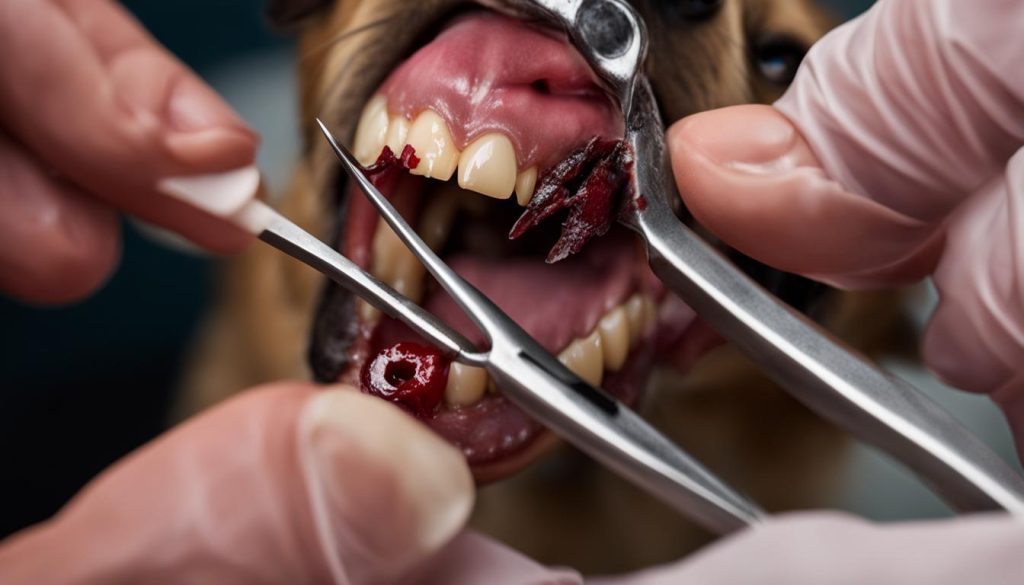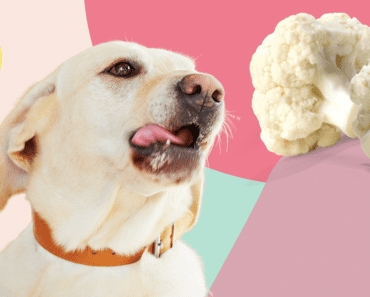Hello, dog owners! As a pet lover, I understand how important it is to keep our furry friends healthy and happy. Today, I want to shed light on a crucial aspect of canine well-being – dental health. Just like humans, dogs can experience dental problems, and it’s our responsibility to ensure they receive the care they need.
Dental diseases in dogs, such as gum disease and tooth decay, can cause discomfort and pain. These issues often stem from plaque buildup, a sticky film of saliva, food debris, and oral bacteria that lingers on your dog’s teeth and gums. If left untreated, plaque can lead to inflammation, tissue destruction, and even tooth loss for your beloved pet.
But fret not! By being aware of the signs of dog teeth problems and taking preventive measures, you can help your furry companion maintain good oral health. Regular oral examinations, dental cleanings, and daily tooth brushing are key to keeping dental diseases at bay. Let’s dive deeper into the signs of dental problems in dogs and explore the solutions available.
Key Takeaways:
- Dog teeth problems, such as gum disease and tooth decay, can cause pain and discomfort.
- Plaque buildup on dogs’ teeth can lead to inflammation, tissue destruction, and tooth loss.
- Signs of dental problems in dogs include red or bleeding gums, bad breath, loose teeth, and difficulty eating.
- Maintaining regular dental care for your dog, including oral examinations and cleanings, is essential for preventing dental diseases.
- Daily tooth brushing and providing appropriate chew toys can help keep your dog’s teeth and gums healthy.
Recognizing Signs of Dog Dental Pain
Recognizing signs of dental pain in dogs can be challenging as they are known to hide their discomfort. However, there are specific symptoms that may indicate dental issues in dogs.
Common symptoms of dental problems in dogs include:
- Red or bleeding gums
- Blood on chew toys
- Vocalizing when yawning or eating
- Loose teeth
- Bad breath
- Lumps or bumps in the mouth
- Ropey or bloody saliva
- Head shyness (hesitant to have their head touched)
- Difficulty picking up food or dropping food while eating
- Chewing on one side of the mouth
- Nasal discharge and sneezing
If you notice any of these symptoms in your dog, it’s important to be vigilant and seek veterinary care for a proper diagnosis and treatment.
Early detection and treatment of gum disease in dogs and dog tooth decay are key to preventing further complications and ensuring your furry friend’s oral health. Regular dental check-ups, professional cleanings, and a good oral care routine can help maintain your dog’s healthy smile.
Treating Dog Dental Pain
When it comes to addressing dental pain in dogs, it’s crucial to target the underlying dental disease. This necessitates a comprehensive oral health assessment and treatment, known as COHAT, which is typically performed under general anesthesia.
During the COHAT procedure, your veterinarian will start by conducting a thorough oral examination to assess the state of your dog’s teeth and gums. This includes evaluating the severity of any dental issues and determining the appropriate course of treatment.

Dental cleaning, another crucial aspect of COHAT, involves removing plaque and tartar buildup from your dog’s teeth. This not only helps improve their oral health but also prevents the progression of dental diseases. In some cases, X-rays may be taken to gain a better understanding of the condition of the teeth and gums.
Depending on the extent of the dental issues, your veterinarian might recommend dog tooth extraction to remove diseased teeth that are causing pain and potential complications. In more advanced cases, advanced dental procedures such as root canals may be necessary to address specific dental problems.
Pain Medication and Antibiotics
After the COHAT procedure, your veterinarian may prescribe pain medication to alleviate your dog’s dental pain. This helps ensure their comfort during the recovery process. Additionally, antibiotics might be prescribed to prevent and treat any potential infections that may arise as a result of the dental procedures.
It’s essential to closely follow your veterinarian’s post-treatment instructions, including administering medications as prescribed and providing any necessary follow-up care. This will help facilitate a smooth recovery and optimize the outcomes of the dental treatment.
In summary, treating dog dental pain involves comprehensive oral health assessment and treatment (COHAT) under general anesthesia. This includes thorough oral examination, dental cleaning, X-rays, and, if necessary, extraction of diseased teeth or advanced procedures. Pain medication and antibiotics may be prescribed to ensure your dog’s comfort and prevent infection.
Preventing Dog Teeth Problems
To ensure your dog’s oral health, it’s essential to take proactive measures and prevent dental problems. Focusing on a combination of home care and regular veterinary care is key.
The cornerstone of oral care for dogs is daily tooth brushing with pet toothpaste. This simple routine helps remove plaque, the sticky film that forms on teeth. Plaque can harbor harmful bacteria and eventually harden into tartar, leading to dental diseases in dogs. By brushing your dog’s teeth every day, you can prevent the buildup of plaque and maintain their dental health.
Additionally, providing your dog with daily chew toys can contribute to their oral care regimen. Chewing on appropriate toys can help clean their teeth and massage their gums, promoting good oral hygiene. However, it’s important to avoid giving your dog hard treats and toys that can cause dental damage or pose a choking hazard.
Feeding your dog high-quality dog food is another crucial aspect of preventing dental diseases. Good nutrition supports overall health, including oral health. By opting for a balanced and nutritious diet, you can help maintain strong teeth and gums in your canine companion.
Regular check-ups with your veterinarian are essential for preventing dental issues in dogs. During these visits, your vet will conduct comprehensive dental examinations, cleanings, and may perform X-rays to assess your dog’s dental health thoroughly. These procedures are usually done under general anesthesia to ensure a thorough evaluation and minimize discomfort for your furry friend.
By prioritizing oral care for dogs through daily tooth brushing, providing chew toys, feeding them high-quality dog food, and scheduling regular veterinary dental care, you can effectively prevent dog teeth problems and maintain your dog’s oral health.
Conclusion
Taking care of your dog’s teeth is crucial for their overall health and well-being. Dental problems in dogs can cause pain, tooth loss, and difficulty eating. It is important to be aware of the signs of dental issues and seek prompt veterinary care when necessary. By prioritizing oral care for dogs through regular dental maintenance, pet owners can help prevent dental diseases and ensure their furry friends have healthy and pain-free mouths.
Regular dental care should include daily tooth brushing with pet toothpaste to remove plaque and prevent tartar buildup. Additionally, annual dental cleanings performed by a veterinarian are an essential part of maintaining your dog’s oral health. These cleanings allow for a thorough examination and removal of any plaque or tartar that may have accumulated. During these visits, X-rays may also be taken to assess the condition of your dog’s teeth and gums.
Providing appropriate chew toys is another important aspect of oral care for dogs. Chew toys help promote dental health by stimulating the gums and helping to remove plaque. However, it is crucial to avoid giving dogs hard treats or toys that can potentially damage their teeth.
By being proactive in caring for your dog’s teeth, you can prevent dental problems and ensure your canine companion maintains good oral health. Remember, a healthy mouth leads to a happier and healthier dog overall.
FAQ
What are the signs of dental problems in dogs?
The signs of dental problems in dogs include red or bleeding gums, bad breath, loose teeth, difficulty eating, and blood on chew toys. Other signs may include lumps or bumps in the mouth, ropey or bloody saliva, head shyness, difficulty picking up food, chewing on one side of the mouth, and nasal discharge and sneezing.
How can I treat dental pain in my dog?
The best treatment for dental pain in dogs is addressing the underlying dental disease. This often requires comprehensive oral health assessment and treatment (COHAT), which includes a thorough oral examination, dental cleaning, and may involve X-rays to evaluate the teeth and gums. Depending on the severity, extraction of diseased teeth or advanced dental procedures like root canals may be necessary. Pain medication and antibiotics may also be prescribed for relief and prevention of infection.
How can I prevent dental problems in my dog?
Preventing dental problems in dogs involves a combination of home care and regular veterinary care. Daily tooth brushing with pet toothpaste is highly recommended to remove plaque and prevent tartar buildup. Providing daily chew toys can also help clean a dog’s teeth and massage their gums. It’s important to avoid feeding dogs hard treats and toys that can cause dental damage. Good-quality dog food and regular dental examinations, cleanings, and X-rays under general anesthesia are crucial for maintaining a dog’s oral health.
Why is taking care of a dog’s teeth important?
Taking care of a dog’s teeth is essential for their overall health and well-being. Dental problems in dogs can lead to pain, tooth loss, and difficulty eating. By recognizing the signs of dental issues and seeking prompt veterinary care, pet owners can ensure their furry friends have healthy and pain-free mouths. Regular dental care, including daily tooth brushing, annual dental cleanings, and providing appropriate chew toys, can help prevent dental problems and maintain optimal oral health in dogs.






